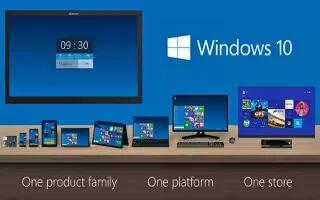The challenging feature of Operating Systems makes Microsoft to announce Windows 10; touted as companys “most comprehensive platform, ever,” Windows 10 stresses a single product family, platform, and store.
The new OS primarily does away with the dependency on the tiled Metro UI that Microsoft had tried to implement across its entire device line, from desktop PCs to Surface tablets and Windows Phone devices. In its place may be a combination of the alleged live tiles, present in the areas just like the new Start Menu, and additional Classic Windows expertise that aims to please both touch and keyboard and mouse users.
These provide a quick view of notifications from relevant applications, such as details of new emails, Facebook messages, and weather forecast updates. The company said the facility was intended to make the software seem familiar to both users of Windows 8 and Windows 7.
Windows 10 is such a substantial leap, according to Microsoft’s executive VP of operating systems, Terry Myerson, which the company decided it would be best to skip over Windows 9, the widely expected name for the next version.
“It’s extremely important for Microsoft to get Windows 10 right,” said David Johnson, who watches Microsoft for the consultancy Forrester.
“Windows 8 is only being offered to employees by about one in five organizations right now. Windows 7 is still the de facto standard for enterprise in the desktop environment.
“For Microsoft to continue to be able to get the best and latest technology in the hands of the enterprise workforce all over the world it has to have a vehicle to do that – and Windows 10 is its best shot.”
Across desktop PCs as a whole, only 13.4% currently run Windows 8 or Windows 8.1, according to research firm NetMarketshare.
By contrast, it says 51.2% are powered by Windows 7 and 23.9% by Windows XP, a version that is no longer supported by Microsoft.
Mr Johnson said the reintroduction of the Start Menu should help Windows 10 fare better.
“It is critically important,” he said.
“The Start Menu is perhaps the most important thing that will make the desktop experience familiar to business users, and will help reduce resistance to its installation.”

Other features include:
- Snap enhancements – a new “quadrant layout” will allow four apps to be easily arranged on the same screen
- Task view – a new button on the task bar will let the user see all open apps and files, helping them switch from one to another
- Multiple desktops – users can switch between distinct desktop screens, allowing them to group related work together rather than having to deal with a single screen overloaded with documents and apps. This is similar to a feature already available on Apple’s Mac OS
Windows 10 is expected to release in fall 2015. Starting tomorrow, Microsoft will open up the OS to dedicated beta testers under its Windows 10 “Insider Program.”
Myerson refused to talk about the Windows business model following reports earlier this week that Microsoft may make Windows upgrades free, as Apple does with its OS X upgrades. Both executives are also confident that the jump from Windows 8 to Windows 10 will not cause confusion, and that customers will respect its symbolic value.
“It’s a name that resonated best with what we’ll deliver,” Myerson said.
